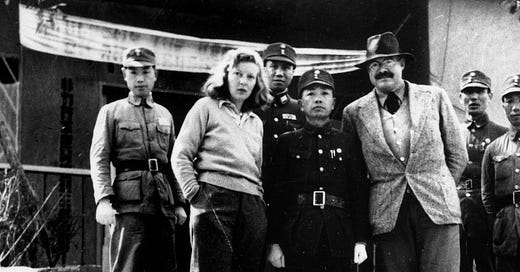“Are you a war correspondent or wife in my bed?”
Ernest Hemingway in a cable to Martha Gellhorn
In May 1944 “the Hemingways” - Ernest Hemingway and his third wife, Martha Gellhorn - were living in Havana, Cuba. Gellhorn by this time had established herself as a distinguished war correspondent, having covered the Spanish Civil War, reported on Hitler’s ascendancy, and travelled to Hong Kong and Burma where she’d reported on the China-Japan War, for the publication Collier’s Weekly. Hemingway was, well, Hemingway, having already written five novels including For Whom the Bell Tolls, two non-fiction books and six story collections.
Closely following events unfolding in Europe, Gellhorn was itching to travel to the front. Hemingway wanted to stay in Cuba.
Undeterred, Gellhorn reached out to her friend, Roald Dahl, who was then Assistant Air Attache at the British Embassy in Washington. Dahl arranged passage for the two to fly to London on an RAF plane, but at the last minute Hemingway informed Gellhorn that women were not allowed on the flight and flew back to London alone. Gellhorn was forced to hitch a ride on a Norwegian freighter and sail from Havana to London. The journey took three weeks.
By the time Gellhorn arrived in London, Hemingway had found a mistress (journalist and future fourth wife, Mary Welsh) and secured Collier’s one journalist accreditation to cover the Normandy landing. Given his fame, Hemingway could have had his pick of publications, but instead chose to offer his services to Collier’s, the publication Gellhorn corresponded for, effectively undermining her chances of reporting on the war. At the time, press credentials were hard to come by, especially for female journalists who were kept far from the frontline.
Gellhorn, however, was determined to go.
With credentials in hand, on June 6, 1944, Hemingway sailed for the beaches of Normandy in a navy vessel. As they neared the coast he was transferred to a small boat. From his place on the boat he watched the landing unfold. He would later write about it in a way that ensured his presence loomed large over the day’s event.
“The story of all the teamwork behind that has to be written, but to get all that in would take a book, and this is simply the account of how it was in a LCV(P) on the day we stormed Fox Green beach.”
(bold and italics mine…To be clear, Hemingway did not ‘storm’ anywhere.)
Back in London, Gellhorn once again took matters into her own hands. On the London docks, despite having no current press credentials, Gellhorn managed to talk her away onto a hospital ship and then promptly locked herself in a bathroom and didn’t emerge until the ship was well at sea.
Unlike Hemingway, Gellhorn made it onto the actual beach at Normandy, going ashore with medical teams, where she helped to carry stretchers and transport the wounded to the ship. She was the only woman to set foot on the beaches during the landing.
She later wrote of her departure from the beach as they returned to the hospital ship:
Her reporting on the landing ran in Collier’s Weekly.
Six months after their respective returns from Normandy, Hemingway and Gellhorn divorced.
A year later, Gellhorn was in Germany, and present at the liberation of the Dachau camp. She wrote:
In 1966, at the age of 58, she was on the ground in Saigon reporting on the Vietnam War. In 1993 at the age of 85 she went to Brazil to report on street children.
She died in 1998 at the age of 89, internationally recognised as one of the greatest war correspondents of all times.
“War happens to people, one by one. That is really all I have to say and it seems to me I have been saying it forever. Unless they are immediate victims, the majority of mankind behaves as if war was an act of God which could not be prevented; or they behave as if war elsewhere was none of their business. It would be a bitter cosmic joke if we destroy ourselves due to atrophy of the imagination.”
― Martha Gellhorn




